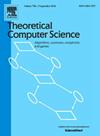Matching cut and variants on bipartite graphs of bounded radius and diameter
IF 1
4区 计算机科学
Q3 COMPUTER SCIENCE, THEORY & METHODS
引用次数: 0
Abstract
In the Matching Cut problem we ask whether a graph G has a matching cut, that is, a matching which is also an edge cut of G. We consider the variants Perfect Matching Cut and Disconnected Perfect Matching where we ask whether there exists a matching cut equal to, respectively, contained in a perfect matching. In addition, in the problem Maximum Matching Cut we ask for a matching cut with a maximum number of edges. The last problem we consider is d-Cut where we ask for an edge cut where each vertex is incident to at most d edges in the cut.
We investigate the computational complexity of these problems on bipartite graphs of bounded radius and diameter. Our results extend known results for Matching Cut and Disconnected Perfect Matching. We give complexity dichotomies for d-Cut and Maximum Matching Cut and solve one of two open cases for Disconnected Perfect Matching. For Perfect Matching Cut we give the first hardness result for bipartite graphs of bounded radius and diameter and extend the known polynomial cases.
半径和直径有界二部图的匹配切割和变体
在匹配切问题中,我们问一个图G是否有匹配切,即一个匹配也是G的一个边切。我们考虑完美匹配切和断开完美匹配变体,我们问是否存在一个匹配切,分别等于,包含在一个完美匹配中。此外,在最大匹配切问题中,我们要求具有最大数量边的匹配切。我们考虑的最后一个问题是d- cut,我们要求一个边切割,其中每个顶点在切割中最多与d条边相关。我们研究了这些问题在有界半径和直径的二部图上的计算复杂度。我们的结果扩展了已知的匹配切割和断开完美匹配的结果。给出了d-切和最大匹配切的复杂度二分类,并解决了断开完美匹配的两种开放情况之一。对于完美匹配切割,我们给出了半径和直径有界的二部图的第一硬度结果,并推广了已知的多项式情况。
本文章由计算机程序翻译,如有差异,请以英文原文为准。
求助全文
约1分钟内获得全文
求助全文
来源期刊

Theoretical Computer Science
工程技术-计算机:理论方法
CiteScore
2.60
自引率
18.20%
发文量
471
审稿时长
12.6 months
期刊介绍:
Theoretical Computer Science is mathematical and abstract in spirit, but it derives its motivation from practical and everyday computation. Its aim is to understand the nature of computation and, as a consequence of this understanding, provide more efficient methodologies. All papers introducing or studying mathematical, logic and formal concepts and methods are welcome, provided that their motivation is clearly drawn from the field of computing.
 求助内容:
求助内容: 应助结果提醒方式:
应助结果提醒方式:


